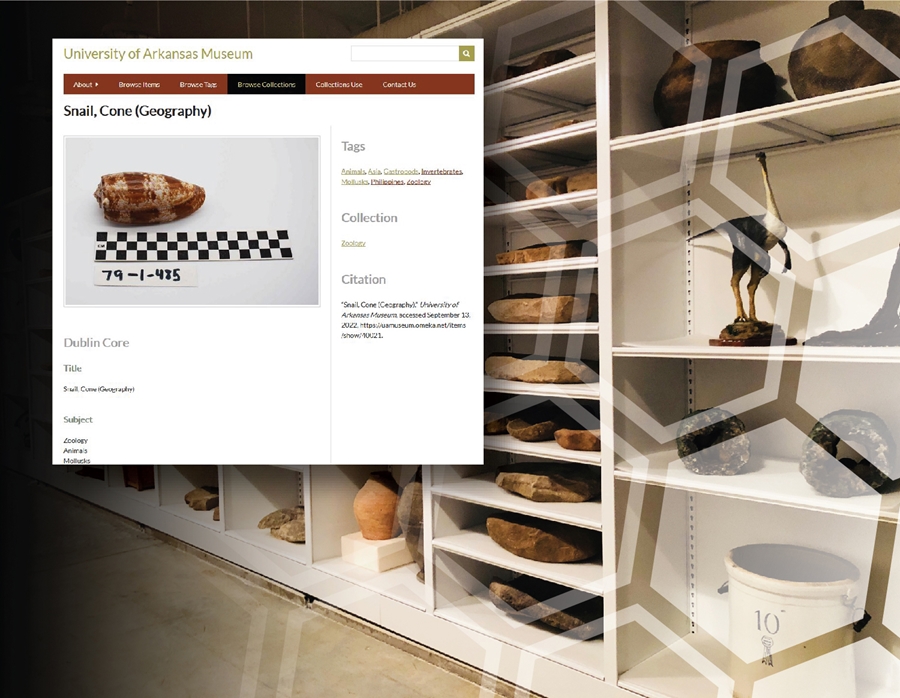
The U of A Museum collections just became more accessible than ever before.
From the first computer on campus to a meteorite that fell near Fayetteville in 1934, the museum houses a highly varied collection of more than 7.5 million objects encapsulating archeology, history, ethnology, geology and zoology.
A new online resource will feature these collections.
Museum staff and volunteers have established an online museum database available to the public. The database is hosted through Omeka, a platform for sharing digital collections and creating media-rich online exhibits.
"The database will transform how people explore and utilize the collections," said Laurel Lamb, curator and project lead. "Until recently, only an internal database existed. Staff acted as a go-between for researchers and that database. While staff will happily continue to assist researchers as always, placing those search tools in the hands of the public as well will expand and enhance usage."
The new database is core to supporting the museum's work, which is dedicated to preserving and sharing Earth's diverse cultural and natural history inclusively for Arkansans and all through active research, education and outreach. In establishing the database, Lamb said the term "all" has been at the forefront of her mind.
"Whether you're browsing highlights of the museum for curiosity's sake or narrowing specific objects for a research project, it has been developed for a wide range of purposes and users," Lamb said.
The U of A campus community is especially encouraged to access this resource. Since its early origins as a teaching collection in the 1870s, the museum has long hosted U of A students and faculty. Within the first month of the fall semester, three separate art history classes have already visited the collections to study cultural materials from around the world. Providing digital access to the objects through the database will enhance such experiences.
The resource will foster new users as well. For instance, students can engage in unique and unexpected research experiences while faculty members can find inspiration for their classes through tangible materials that enhance learning.
Lamb said two students have already incorporated the database within projects.
Freshman data science major Ruth Walters began volunteering at the museum over the summer. She assisted with reviewing and revising database entries. Over time, she noticed the museum holds a significant cone snail collection. She honed her focus on these specimen entries and created an accompanying digital exhibit with photographs that link back to specific database entries.
"In transitioning the University of Arkansas' collection to a virtual environment, our goal is to test the limits of what defines a museum display — allowing those who cannot get to a museum the opportunity to 'walk' through an exhibit," said Ernest Gann, president of the museum's Advisory Council, in reference to upcoming exhibits displayed on the new resource. "I believe Omeka to be a wonderful resource to help us accomplish this and see the museum's vision fulfilled."
Senior history major Garrett Sherman is currently developing a different project — an interactive timeline that will contextualize specific Roman archeological materials in the collections within larger historical events that were happening around them. Each featured object will link directly back to its database entries for those interested in learning more.
"My experience using Omeka has taught me a lot," Sherman said. "The eventual integration of Omeka into my timeline project will make for a deeper and more educational experience when viewing and accessing the project."
David McNabb, interim associate dean of Fulbright College, commended the museum staff and volunteers for their work in bringing this resource to the university and state.
"This group has been working hard for months to make this resource accessible, public and easy to use — and their work will be transformative to how we explore artifacts and objects from the University of Arkansas' impressive history of innovation, research and service," McNabb said. "I'm eager to see how our students, teachers and researchers take advantage of this incredible new resource."
With such a vast collection in the museum, there are still many entries not yet published. However, new ones are added each week with the goal of making the entire collection searchable for everyone.
Click here to visit this exciting new resource here.
To learn more and speak with museum staff, contact Laurel Lamb at lalamb@uark.edu / 479-575-4370.
About the University of Arkansas Museum: The University of Arkansas Museum is an administrative unit of the Fulbright College of Arts and Sciences. University faculty may request loans of specimens for their classes or arrange to bring their classes for a visit. Specimens and their associated documentation are available for comparative and research purposes by faculty, qualified students, and visiting scholars. The museum also fulfills its public service and outreach mission through community engagement programs and loans to other institutions for exhibits. Visiting the collections requires an appointment with museum staff. Learn more on the museum's website.
Contacts
Laurel Lamb, curator of education and engagement
University of Arkansas Museum
479-575-4370, lalamb@uark.edu